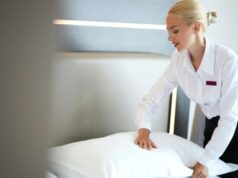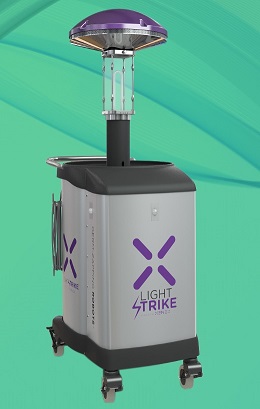
NATIONAL REPORT—Earlier this year the Westin Houston Medical Center announced it was using LightStrike Germ-Zapping Robots to sanitize and disinfect its guestrooms and common areas to help combat the threat of coronavirus. The robots use intense germicidal UV light to disinfect rooms by quickly destroying microscopic bacteria and viruses that may be missed during the manual cleaning process. Operated by hotel staff, the robot uses pulsed xenon (a noble gas) to create intense broad-spectrum UV light. The room disinfection technology was provided by Xenex Disinfection Services.
Xenex Disinfection Services is just one of a number of companies now selling UV devices that can be moved from one guestroom to another for disinfection. Green Lodging News just featured the Inn at Moonlight Beach on its website. The inn is also using a UV light machine to disinfect each of the Inn’s five suites. The machine is run for 30 minutes within the suite after the suite is cleaned.
Why the need for machines that incorporate UV light? According to Safeology, “In today’s environment, traditional cleaning protocols are no longer enough. Even though they are beneficial, topical germicides typically clean less than 50 percent of surfaces, and may include harmful chemicals and unpleasant odors. In contrast, UVC effectively eliminates 99.9 percent of pathogens within its line of sight.”
What to Know About UV Light
Safeology says, “Ultraviolet light is part of the electromagnetic spectrum, falling between visible light and x-rays. It is classified into three primary groups based on wavelength: Ultraviolet A (UVA), Ultraviolet B (UVB) and Ultraviolet C (UVC). UVC light has a wavelength range of 100 to 280 nanometers (nm) and is widely acknowledged as the most effective light to eradicate germs.”
In addition to Xenex Disinfection Services and Safeology, PURO Lighting, Safe Space Technologies, and UVC PureLight 360 are also providing portable UV disinfection machines.
Typically for Hospital Rooms
The LightStrike Germ-Zapping Robots from Xenex Disinfection Services are positioned for hospital room use but can be used in hotel guestrooms. According to the company, “The LightStrike Germ-Zapping Robots deliver up to 4,300x more germicidal UV pathogen killing intensity than UV-C mercury vapor and can disinfect an entire patient room in as little as 20 minutes.”
“After disinfection, the room will remain disinfected until new pathogens enter the room from a visitor, patient, care provider or the air handling system,” the company says. “A hospital does not need to repeat the Xenex decontamination procedure in a properly cleaned and disinfected room if there has been no re-contamination.”
Xenex has produced several versions of its germ-zapping robots. Each includes several safety mechanisms to prevent accidental exposure.
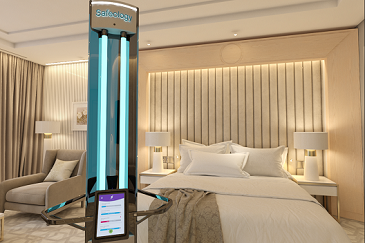
“People should not be directly exposed to the light,” Xenex says. “Although brief exposure to the light is not a threat, the LightStrike Robot’s triple-sensor motion detector will stop the pulses of light within milliseconds. An external ‘stop’ button provides an immediate shutdown should anyone need to re-enter the disinfection area before the cycle is complete.”
Safeology
According to Safeology, “We leverage the science of light to create clean, coronavirus-free spaces.” The company’s Safeology Tower safely, quickly and effectively eliminates up to 99.9 percent of surface and airborne pathogens. The Tower is 74 inches tall for maximum floor to ceiling coverage area. Three PIR sensors ensure auto-shutoff when movement is detected. A touch tablet with integrated wireless charger makes remote control easy and cloud-based system management, review and reporting is included.
PURO UV Disinfection Lighting
PURO UV Disinfection Lighting powered by Violet Defense technology offers its Sentry Mobile series that emits full spectrum UV light to eliminate up to 99.9 percent of the bacteria, fungi, and viruses in the space, and limit the growth of fungi. The Sentry M4 unit has four full spectrum UV Light Engines, arranged in back-to-back pairs. The light distribution and reflectivity of UV provides nearly 360-degree coverage. Each side can be individually height adjusted and powered by a standard wall plug. The Sentry M2-C is armed with two full spectrum UV light engines mounted on locking casters to provide a lightweight mobile disinfection solution. PURO also offers tripod-based disinfection solutions.
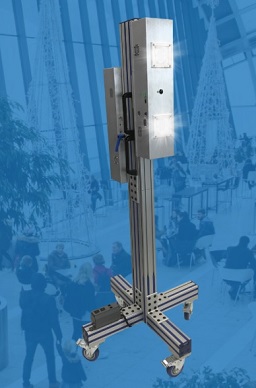
According to PURO, it uses a powerful, broad-spectrum light, including germicidal UV-C, UV-B and anti-bacterial UV-A to optimize their germ-killing efficiency on both surfaces and airborne particles. Accredited specialized labs have confirmed the efficacy of the machines.
Jim Colantoni, Co-Founder & Head of Strategy & Sales for PURO, says his company also offers Helo fixtures for in the ceiling. The full spectrum UV disinfection fixture provides whole room protection. In hospitality, Colantoni says Helo fixtures are ideal for gyms. Not on the PURO website but currently being beta tested with a large hotel group is a fully autonomous robot for common areas that can move through a space by itself to disinfect.
In regard to safety, PURO units are designed to produce enough energy to kill single celled organisms, so incidental exposure by humans would be similar to being out in the sun. OSHA, as well as safety certification standards, however, do have regulations about exposure to UV light and bright flashes, so the units have motion detection technology to ensure that unit operation stops when people or animals are present. Colantoni says the company also offers external controls for outside the guestroom to turn off the machine.
PURO products are designed to run in 15- or 30-minute increments.
When asked what questions one should ask a supplier before purchasing a UVC disinfection system, Colantoni said, “How long have you been in business? Can you provide data on the full device? Is the company and its facility EPA registered?” He added that the machine should meet a UL standard and have safety certification. Third party data should also show a machine’s effectiveness three to four meters from the machine—the typical scenario in a hotel guestroom.
UVC PureLight 360
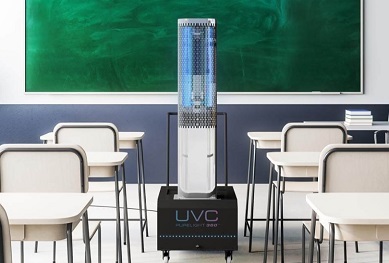
UVC PureLight 360, “the world’s first hybrid UVC induction/LED disinfection system,” kills up to 99.9 percent of surface virus and bacteria in five to 20 minutes (up to 576 square feet). The system features a built-in control panel to select operational cycle (5 min, 10 min, 20 min, 30 min) with 90 second delayed start and warning chime. It includes 4-Sided 360 Degree Motion Sensors to provide automatic shutoff when movement is detected.
Alan Mandel, Co-Founder and CEO of the company, says production of his company’s system will begin by early November. He expects housekeepers will clean the bathroom first, move the machine to the bathroom, clean the bedroom, then move the machine to the bedroom while moving on to the next room.
When asked about training on the machine, Mandel said, “It is basically plug and play.”
He says the system does not sanitize every nook and cranny of the room. “Certain areas still need to be wiped down by hand,” he says.
Safe Space Technologies
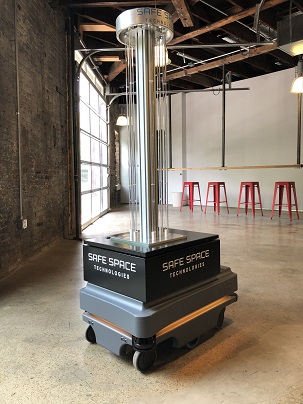
Safe Space Technologies, a Pittsburgh-based robotics company, just announced its line of UVC disinfection solutions. “We have been using UV technology several decades,” says Chris Proud, the company’s CEO. “We have taken our years of experience and applied it to disinfection.”
Safe Space Technologies offers a unique set of solutions for guestrooms and common areas. For the guestroom the UVC Disinfection Cart can be placed either as one unit or separated into four modules to ensure no “shadow” area is left untouched.
“We believe it is a perfect solution,” Proud says. “We are the only company that has a cart that can be used as one unit or as different modules. Hotel staff can separate the modules.” The system can disinfect a 36’ by 36’ room in 20 minutes. Smaller rooms can be disinfected in as little as eight minutes. Built in motion sensors and operation from a remote-controlled tablet ensure safe operation. Intelligent controls allow for usage data to be reported and viewed via the web to track your results.
“Our systems are very high power and very high wattage,” Proud says. “They can disinfect hard and soft surfaces as well as disinfect the air.”
In addition to the UVC Disinfection Cart, Safe Space Technologies offers a Mobile Disinfection Robot. “It is akin to your driverless vehicle,” Proud says. “If it detects a human, it shuts off. It can disinfect 4,000 square feet in one hour.” He says it is ideal for hallways, larger public spaces such as convention hotels, and fitness centers. It automatically avoids obstacles. Data is made available to track the robot’s runtime, location, and disinfection history.
Proud says his company’s machines reduce the amount of manpower to disinfect while also reducing the amount of harsh chemicals.
In Conclusion
Machine costs can vary dramatically from one supplier to another, depending on machine power, portability, and the bells and whistles that come with it—external communication, control and reporting capabilities, for example. Leasing options on more expensive machines may be available. Be sure to ask about impact on items in the room such as soft goods, plants, artwork, etc.
Click here to link to recently posted article entitled, “Organizations Join to Address Safety of UVC Germicidal Devices.”
Glenn Hasek can be reached at greenlodgingnews@gmail.com.



